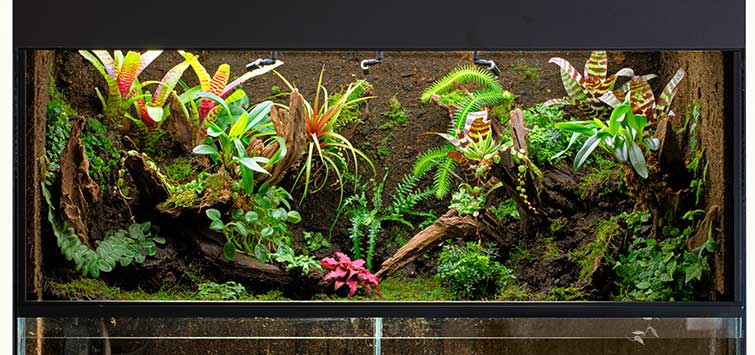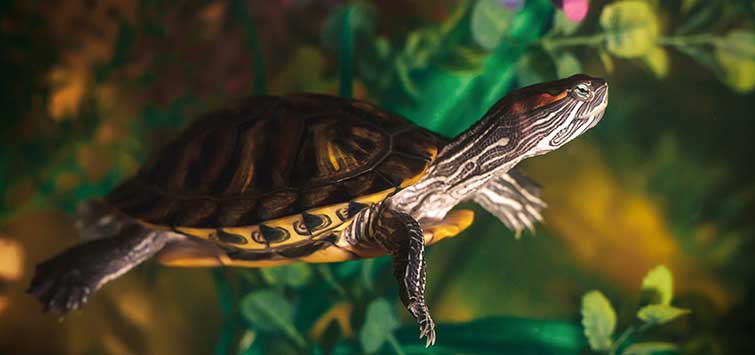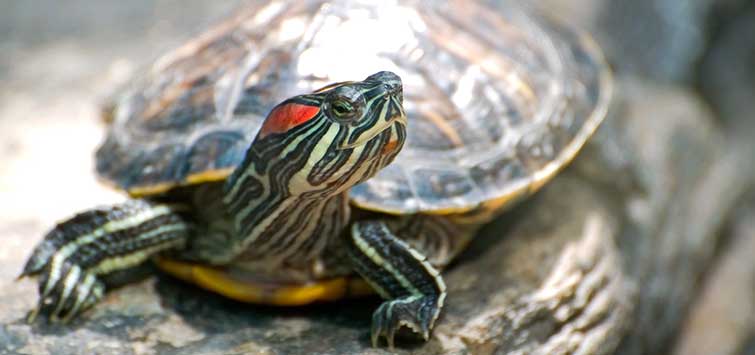Where Land Meets Sea: Creating a Paludarium
Author: Joshua Wiegert
Having a fixed land section allows the aquarist much greater variety when it comes to the type of species that can be included in a setup—even frogs and newts can be added to an otherwise typical aquarium!
Life Near the Shoreline
Like many aquarists, I’ve always been fascinated by aquatic ecosystems in general and spend a great deal of my free time exploring these habitats in their natural state, including streams, ponds, swamps, and wetlands. The transition from the fully aquatic habitat to the terrestrial is one of my favorite areas to explore.
Many fascinating organisms make their homes here. A large variety of interesting aquatic insects may be found along the shoreline of most water bodies, as can amphibians (frogs, toads, newts, salamanders, etc.) and other animals. In some regions, even fishes can be found in moist areas, most notably the various mudskippers. Various crabs and other invertebrates can likewise be found along the edges of water bodies, including the familiar fiddler crabs (Uca spp.).
Beyond animals, the plants found along the shoreline are truly fascinating. Many beautiful flowering varieties exist, and it is often in the marginal areas that the carnivorous plants can be found, ranging from pitcher plants and sundews to the mysterious Venus fly trap.
Simple Paludariums
For aquarists interested in maintaining these and other such organisms, one option is the modified aquarium known as a paludarium. The word “paludarium” derives from the Latin word for swamp. It can be a beautiful way to display a mixed environment as well as an interesting way to link an aquarium to a surrounding room.
While creating a paludarium is not particularly difficult, they—as I will explain later—can become complicated. One of the simplest options is to place potted vine-like plants over the top of the aquarium. One of the most popular choices for this is the pothos Epipremnum pinnatum. This is a commonly sold house plant that can be found at virtually any department store and is sometimes sold in aquarium stores. The vine-like stems of the plant will root in the water, offering hiding places and shelter for smaller fish, as well as removing significant quantities of nutrients. The pothos is noted for its ability to remove airborne pollutants as well.
A second interesting and simple alternative is to place a large piece of driftwood in the aquarium so that it breaks the water surface. Java moss, as well as many other species of moss, will gladly grow over the surface of the wood. Air plants can be glued onto the driftwood. These can include the various Spanish mosses (Tillandsia spp.), other bromeliads, or orchids. These simply need to be misted frequently, even with aquarium water. With a large drill bit and some creativity, it’s also possible to sneak a small pot of soil into the driftwood, thereby increasing the number of possible plants that will survive.
Separating Land from Water
The more technical paludarium involves creating a land area. In order to do this, the aquarium is partially filled, creating a water level, and some sort of shelf is installed, creating a land level. The trick is to separate these two levels. I install a shelf at the waterline level to hold the land. This shelf is made out of PVC (plastic) egg crate,which is essentially a white grid material used to diffuse light from fluorescent ceiling fixtures in commercial and industrial settings. It can be found in 2 x 4-foot sections at most home-improvement stores in their ceiling panel aisle.
Building a Shelf
The egg crate is made from PVC, which is the same material used in most modern plumbing applications, including aquaria. It is inert and won’t leach harmful chemicals into the water. Egg crate is simple to cutusing a pair of heavy-duty scissors, a hacksaw, or a rotary tool’s cutting wheel. As always, wear safety glasses and gloves, especially if using a power tool. The egg crate is cut to make the land section. It can be cut to create islands in a larger aquarium or to cover a third of the tank or more. It could even cover most of the aquarium with a central pool to gain access to the aquatic section.
This shelf could be glued to the edges of the aquarium, but I find it simpler to just use something beneath it for support. If you choose to glue it, keep in mind that it must be able to support the weight of the land area. I used segments of PVC pipe to support mine and skipped the glue.
Petrified wood is also nice because it often comes in column-like shapes. You can use a large screwdriver and a hammer to break it to the desired height. Or, if you want be technical, you could use a real stone chisel. I had a piece with a ledge on it that was roughly the same height as another piece. I cut a semicircular lip into the egg crate and slid it onto the ledge of the higher rock, letting it jut upward.
The egg crate does not even need to cover a large area. Check out the photos for a much smaller emergent area. I simply cut a section of egg crate and secured it using the edges of a piece of rock. This created a single island area.
Making It Look Natural
The egg crate can be covered with gravel. Eventually, the plants will cover it and hide it, and the gravel will not really be needed—I don’t use it. Gravel will fall through the large holes in the egg crate. To work around this, either first place a layer of larger-sized stone and then cover this with aquarium gravel or put down a fine plastic mesh and then cover with gravel. Soil or peat moss can be used to cover this area as well.
Should you choose to use gravel, soil, or some other material, keep in mind that this will trap debris, waste, and the like. The plants will root in this material as well. By avoiding any media on the egg crate, you’re forcing the plants to root into the water, and they will remove dissolved nutrients directly from the water column, helping to filter your water. Also keep in mind that by adding gravel or other media to the upper level, you are adding a lot of weight.
Consider covering the back wall of the aquarium above the land area with a piece of corkboard. This is bark-like wood available at many large aquarium stores, often in their reptile section. You can use a little glue to attach any number of epiphytic plants to this, including air plants and orchids.
Due to the lowered water level, standard methods of filtration are not available. Small submersible filters that are available may help, though they often take up a rather large amount of room. I choose to forego any filtration in most of my paludaria, simply relying on powerheads for water circulation and heavy plant growth for vegetative filtration. The paludarium adds extra plant filtration, removing large amounts of nutrients.
Plants for the Paludarium
Many varieties of plants will do just fine in this setup beyond the aforementioned pothos. Try the peace lily “Brazil sword,” which is commonly featured in betta vases. Spider plants, Croton spp., Dracaena spp., lucky bamboo (which is actually a species of Dracaena), and the like will also work. African violets can add a beautiful flowering arrangement. And, of course, the many carnivorous plants can be installed. Mangroves can also be kept, as can cypress and other semi-aquatic trees, as long as they are dwarfed with a little bonsai work. The possibilities are endless.
Virtually any of the various marginal pond plants will work as well. After all, this is where marginal plants naturally grow. My personal favorite is the cardinal flower (Lobelia cardinalis). Alternatively, many of our aquatic plants will grow just fine with only their roots wet. Try swordplants (Cryptocoryne spp.) and many others. Not only will this give the aquarist an opportunity to witness these plants flowering, but the contrast between submerged and emergent forms can be quite stunning (try wisteria [Hygrophila difformis] for a plant with wildly different growth forms).
For something very different, consider growing herbs in your paludarium. Many varieties of mints, basil, and other pleasant-smelling plants can all be grown with their roots wet. For that matter, a lot of our common fruit and vegetable plants can as well.
Appropriate Paludarium Animals
Newts
For animal life, there are quite a few different possibilities. Almost every aquarium store sells at least one species of newt. The various firebelly newts(Cynops spp.) and Pacific newts(Taricha spp.) are commonly sold. These animals are excellent swimmers and spend much of their time moving between land and water.
In the aquarium, they will eat any frozen, meaty foods, various pellets, and small fishes (be cautious with tankmates). Additionally, the eastern newt (Notophthalmus viridescens) may be frequently encountered. This species has a bright red terrestrial form, known as an eft. As it matures, the eft will turn olive green and begin spending more and more time in the water. Breeding this or any species of newt in the aquarium can be an interesting endeavor.
Salamanders
Many aquarium shops frequently sell aquatic salamander larvae, usually the larvae of the American tiger salamander (Ambystoma tigrinum). These are often sold as axolotls or mudpuppies, which actually are other organisms, or as waterdogs. They’re also frequently available at bait stores. These look like a brown or grayish salamander with huge gills. They are carnivores that will devour essentially any meaty item, from earthworms to fishes.
The larvae are a fascinating addition to an aquarium with either larger, nonaggressive fishes or fast-moving fishes, with the caveat that the fish may be eaten. As they metamorphose into adults, they become jet black with bright yellow or orange spots and stripes on them, depending on the exact subspecies. Adults will migrate to the land area, where they will benefit from peat moss to burrow in and cork board or other structures to hide under. Unfortunately, these salamanders are quite secretive—you won’t see them frequently. Many other species of salamander are sold by specialty shops and make better alternatives.
Frogs
Tadpoles, often of green frogs (Rana clamitans)and bull frogs (R. catesbeiana)are commonly sold, particularly in the spring, as are the tadpoles of any number of other frogs. The paludarium offers the aquarist an excellent opportunity to witness the complete metamorphosis of these amphibians. Any number of other frogs or toads may be maintained in the paludarium, barring those species that seem to be poor swimmers.
Fishes
The selection of fishes that will take advantage of the land area is extremely limited. For the most part, fish tend to like staying in the water—I seem to remember this from one of my ichthyology classes. The notable exceptions are the mudskippers, a small group of gobies that will actually leave the water. These are brackish-water fishes. Check out the TFH Extras blog at www.tfhmagazine.com/blogs for information on how to create a brackish-water paludarium.
The paludarium can be of great benefit to fishes, however. The heavy root growth in the water provides an excellent hiding spot for fry and young fishes as well as just an interesting shelter for smaller species. Furthermore, algae may grow on the roots, which can provide a grazing surface for small fry. The heavy root growth also provides a natural shelter for shy fishes. You’ll often find fishes such as the Badis, dwarf cichlids, and other more timid fishes hiding in the heavy growth. Additionally, as the roots develop into a tangle, particularly if mosses or algae are allowed to grow, they will provide a spawning media for egg scatterers. Danios, rasboras and other cyprinids, killifishes, and many others will all spawn in the roots of emergent vegetation. Also, in the case of light-sensitive species (e.g., neon tetras), where the eggs or fry are damaged by light, the upper island will provide shade, protecting the spawn.
In the case of nocturnal fishes, the overhanging shelf will create a natural cave, similar to that of an undercut bank along a stream’s edge. You’ll find Synodontis catfishes hanging (often upside down) along the ledges. Other catfishes will similarly use this as a shelter.
The cave will also provide a natural spawning area for cave spawners. Countless species of Mesoamerican and West African cichlids are cave spawners, and even mouthbrooding mbuna will retreat to areas like this while holding. Essentially, if the fish will spawn inside of a flowerpot, they’ll spawn here.
Blending Land and Sea
If you’re looking for an interesting challenge, try a paludarium. Not only does it open up entirely new areas of organisms and plants to the aquarist, but it can be a beautiful feature. When surrounded by potted plants, the paludarium can flow from inside the tank to the room.
Super Carnivore Tank
For those aquarists more interested in plants than fishes, another option is to create a small peat bog. Instead of cutting the egg crate to form an island surface, cut it to form a tank divider. It should be as wide as the tank, but only about three quarters as high. Fill one side of the divider with loose peat moss—the still-stringy variety sold as potting media for orchids. (Alternatively, use Java moss—it’ll continue to grow.) You may have to soak the moss so it’ll sink, and be aware that it willexpand.
Fill the aquarium roughly one-half full, and, for best results, use distilled water. The moss will absorb water, and you may have to adjust its volume, but it should be wet through the surface. This bog area is the ideal substrate for carnivorous plants, including sundews, pitchers, and the like. Many varieties of non-carnivorous plants can also be grown here, ranging from cranberries to cardinal flowers.
Adding a pump to circulate the water will greatly help. A powerhead at the far end of the aquarium, with a hose directing its flow into the moss, is perfect. The peat moss will result in a low pH. Carnivorous plants tend to prefer low nutrient levels, especially low nitrogen. Therefore, keep the tank lightly stocked and lightly fed. One could maintain a pair of apistos, a pair of Bettas or other labyrinth fishes, or perhaps a small school of cardinal tetras.
Assuming the aquarium was quite large, it would make an interesting home for discus. Small fish may move through the egg crate divider into the moss area and potentially even use it as a spawning area. I keep a tank like this full of Endler’s livebearers.
See the full article on TFH Digital http://www.tfhdigital.com/tfh/201202#pg81

.png?h=595&iar=0&w=2781&hash=5FD5E69473BCC22199FBFA2FB71B6033)



